service CHEVROLET CAMARO 1997 4.G Owners Manual
[x] Cancel search | Manufacturer: CHEVROLET, Model Year: 1997, Model line: CAMARO, Model: CHEVROLET CAMARO 1997 4.GPages: 404, PDF Size: 20.96 MB
Page 3 of 404
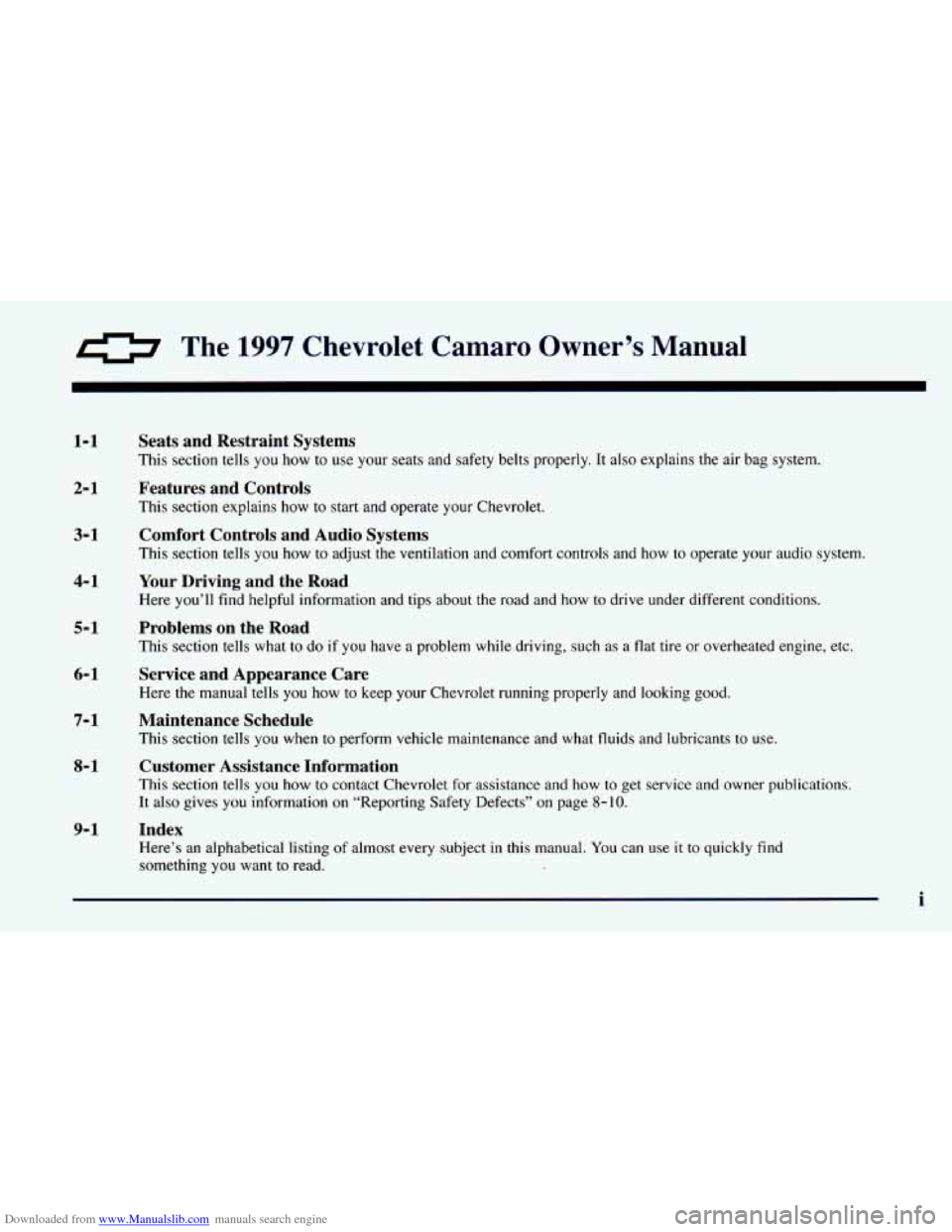
Downloaded from www.Manualslib.com manuals search engine 0 The 1997 Chevrolet Carnaro Owner’s Manual
1-1
2- 1
3-1
4- 1
5- 1
6- 1
7- 1
8-1
9- 1 Seats and Restraint Systems
This section tells you how to use your seats and safety belts\
properly. It also explains the air bag system.
Features and Controls
This section explains how to start and operate your Chevrolet. \
Comfort Controls and Audio Systems
This section tells you how to adjust the ventilation and comfort controls and how to operate your audio \
system.
Your
Driving and the Road
Here you’ll find helpful information and tips about the road\
and how to drive under different conditions.
Problems on the Road
This section tells what to do if you have a problem while driving, such as a flat tire or overheated engine, etc.
Service and Appearance Care
Here the manual tells you how to keep your Chevrolet running properly and looking good.
Maintenance Schedule
This section tells you when to perform vehicle maintenance and \
what fluids and lubricants to use.
Customer Assistance Information
This section tells you how to contact Chevrolet for assistance \
and how to get service and owner publications.
It also gives you information on “Reporting Safety Defects” o\
n page 8- 10.
Index
Here’s an alphabetical listing of almost every subject in this manual. You can use it to quickly find
something you want to read.
i
Page 4 of 404
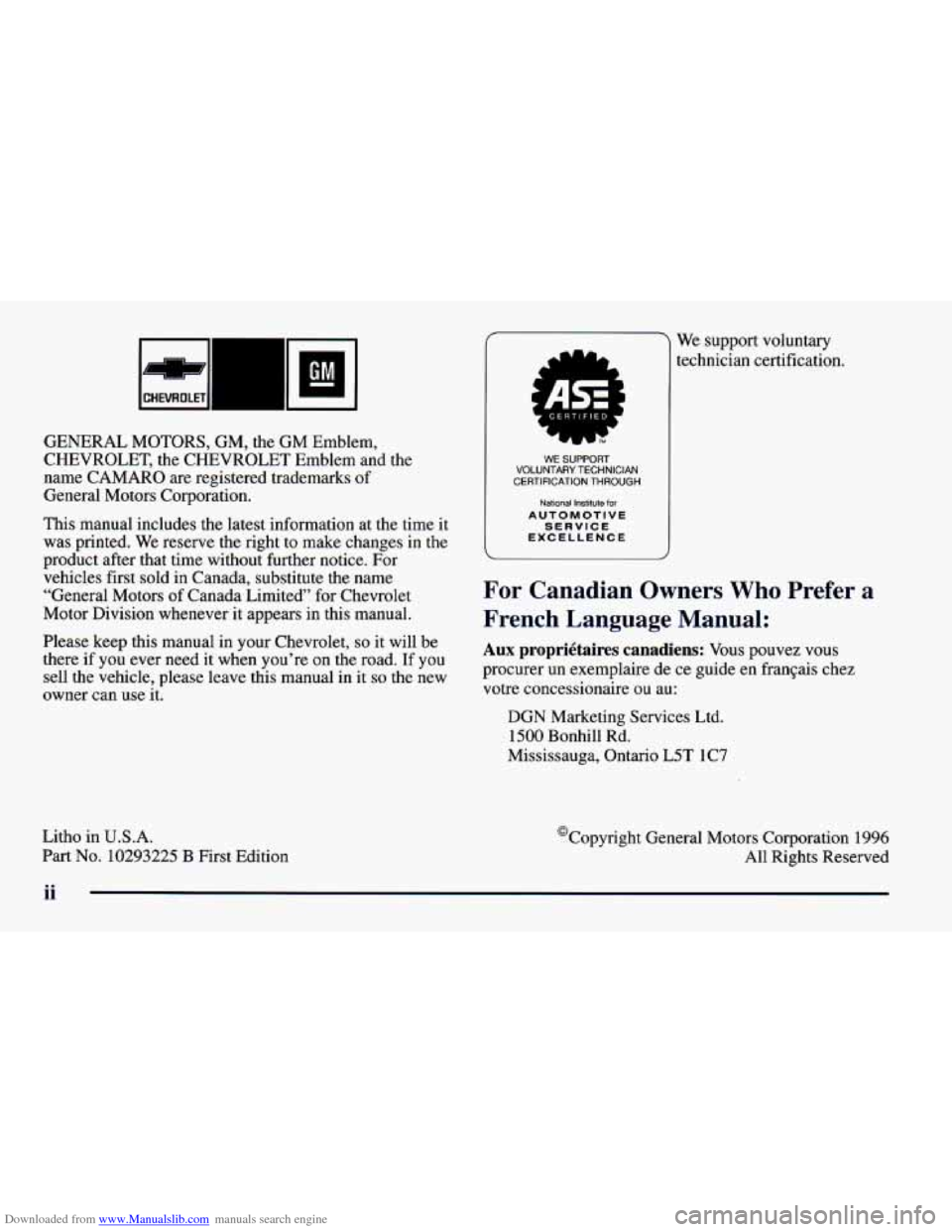
Downloaded from www.Manualslib.com manuals search engine GENERAL MOTORS, GM, the GM Emblem,
CHEVROLET, the CHEVROLET Emblem and
I
name CAMARO are registered trademarks of
General Motors Corporation.
This manual includes the latest information at the time
it
was printed. We reserve the right to make changes in the
product after that time without further notice. For
vehicles first sold in Canada, substitute the name
“General Motors of Canada Limited” for Chevrolet
Motor Division whenever it appears in this manual.
Please keep this manual in your Chevrolet,
so it will be
there if you ever need it when you’re on the road.
If you
sell the vehicle, please leave this manual in it
so the new
owner can
use it.
Litho in
U.S.A.
Part No. 10293225 B First Edition the
L..A
CERTIFIED
rwr TM
WE SUPPORT VOLUNTARY TECHNICIAN
CERTIFICATION THROUGH
AUTOMOTIVE
National Institute for
SERVICE
EXCELLENCE
We support voluntary
technician certification.
For Canadian Owners Who Prefer a
French Language Manual:
Aux proprictaires canadiens: Vous pouvez vous
procurer un exemplaire de
ce guide en fraqais chez
votre concessionaire
ou au:
DGN Marketing Services Ltd.
1500 Bonhill Rd.
Mississauga, Ontario
L5T IC7
@Copyright General Motors Corporation 1996
All Rights Reserved
ii
Page 34 of 404
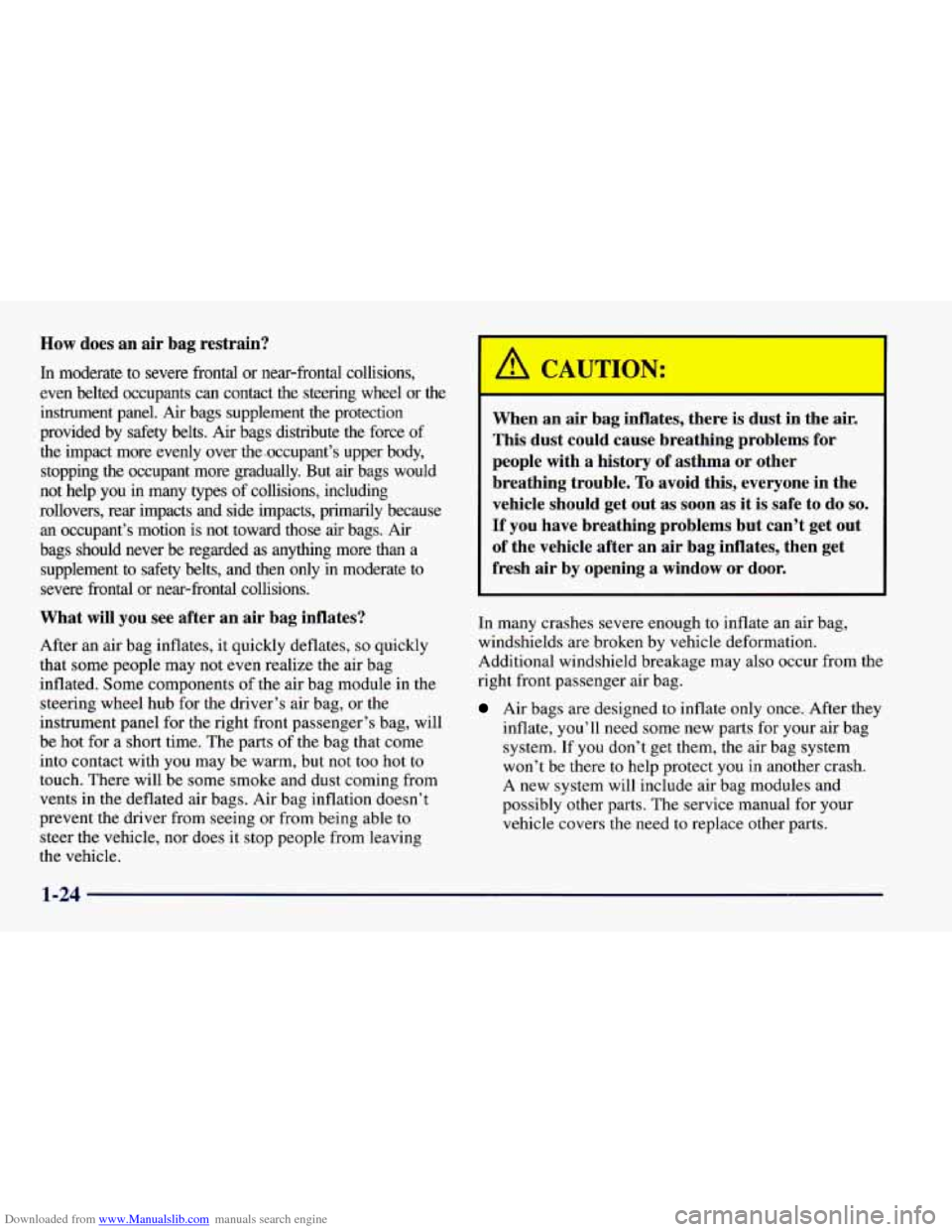
Downloaded from www.Manualslib.com manuals search engine How does an air bag restrain?
In moderate to severe frontal or near-frontal collisions,
even belted occupants can contact the steering wheel or the
instrument panel.
Air bags supplement the protection
provided by safety belts. Air bags distribute the force of
the impact more evenly over the .occupant’s upper body,
stopping the occupant more gradually. But air bags would
not help you in many types of collisions, including
rollovers, rear impacts and side impacts, primarily because
an occupant’s motion is not toward those
air bags. Air
bags should never be regarded as anything more than a
supplement to safety belts, and then only in moderate to
severe frontal or near-frontal collisions.
When an air bag inflates, there is dust in the air.
This dust could cause breathing problems for
people with a history of asthma or other
breathing trouble.
To avoid this, everyone in the
vehicle should get out as soon
as it is safe to do so.
If you have breathing problems but can’t get out
of the vehicle after an air bag inflates, then get
fresh air by opening a window or door.
What will you see after an air bag inflates?
After an air bag inflates, it quickly deflates, so quickly
that some people may not even realize the air bag
inflated. Some components
of the air bag module in the
steering wheel hub for the driver’s air bag, or the
instrument panel for the right front passenger’s bag, will
be hot for a short time.
The parts of the bag that come
into contact with you may be warm, but not too hot to
touch. There will be some smoke and dust coming from
vents in the deflated air bags. Air bag inflation doesn’t
prevent the driver from seeing or from being able
to
steer the vehicle, nor does it stop people from leaving
the vehicle. In
many crashes severe enough
to inflate an air bag,
windshields are broken by vehicle deformation.
Additional windshield breakage may also occur from the
right front passenger air bag.
Air bags are designed to inflate only once. After they
inflate, you’ll need some new parts for your air bag
system. If
you don’t get them, the air bag system
won’t be there to help protect you in another crash.
A new system will include air bag modules and
possibly other parts. The service manual for your
vehicle covers the need to replace other parts.
Page 35 of 404
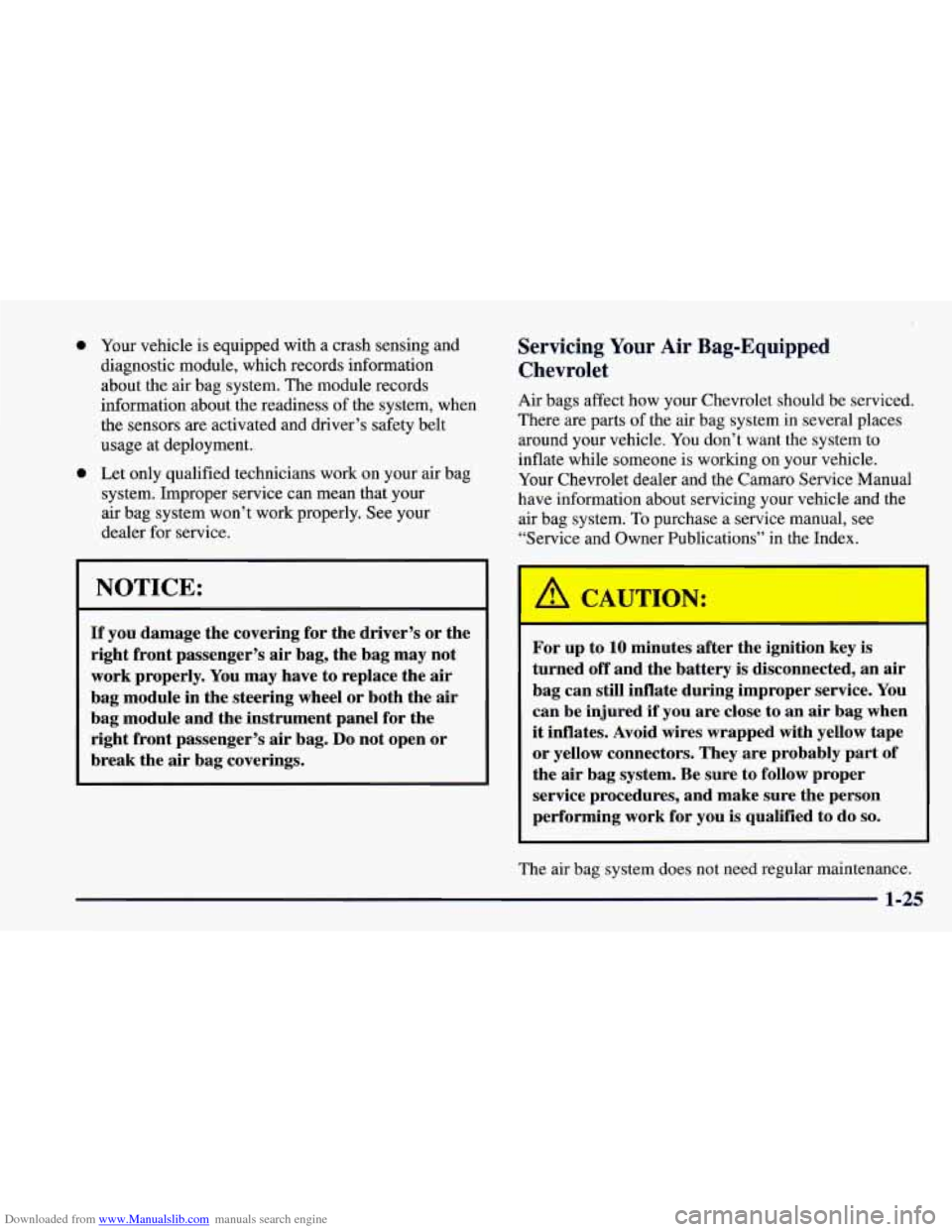
Downloaded from www.Manualslib.com manuals search engine 0 Your vehicle is equipped with a crash sensing and
diagnostic module, which records information
about the air bag system. The module records
information about the readiness of the system, when
the sensors are activated and driver’s safety belt
usage at deployment.
0 Let only qualified technicians work on your air bag
system. Improper service can mean that your
air bag system won’t work properly. See your
dealer for service.
Servicing Your Air Bag-Equipped
Chevrolet
Air bags affect how your Chevrolet should be serviced.
There are parts of the air bag system in several places
around your vehicle.
You don’t want the system to
inflate while someone is working on your vehicle.
Your Chevrolet dealer and the Camaro Service Manual
have information about servicing your vehicle and the
air bag system. To purchase a service manual, see
“Service and Owner Publications” in the Index.
NOTICE:
If you damage the covering for the driver’s or the
right front passenger’s
air bag, the bag may not
work properly. You may have to replace the
air
bag module in the steering wheel or both the air
bag module and the instrument panel for the
right front passenger’s
air bag. Do not open or
break the
air bag coverings. For up
to
10 minutes after the ignition key is
turned off and the battery is disconnected, an air
bag can still inflate during improper service. You
can be injured
if you are close to an air bag when
it inflates. Avoid wires wrapped with yellow tape
or yellow connectors. They are probably part of
the air bag system. Be sure to follow proper
service procedures, and make sure the person
performing work for you is qualified to do
so.
The air bag system does not need regular maintenance.
1-25
Page 57 of 404
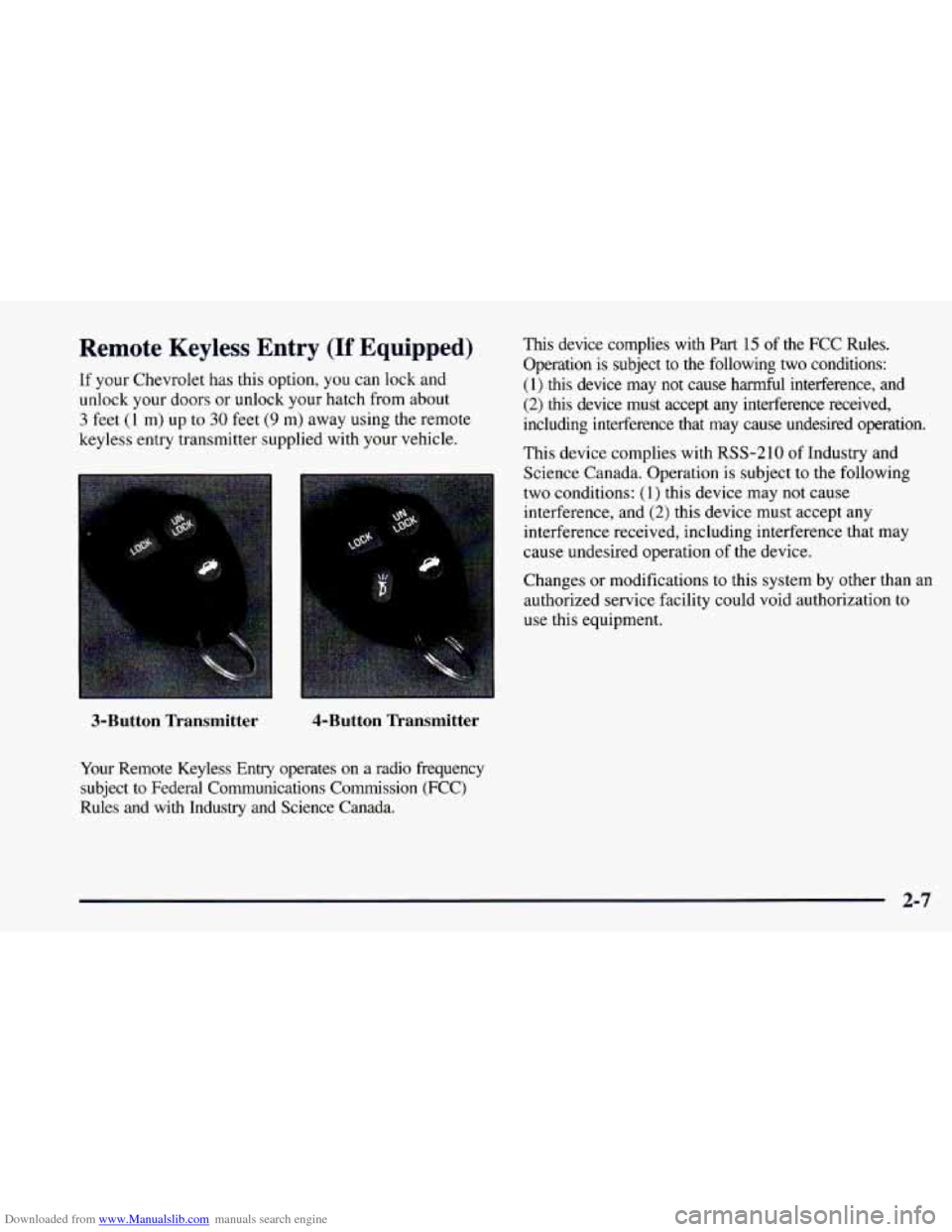
Downloaded from www.Manualslib.com manuals search engine Remote Keyless Entry (If Equipped)
If your Chevrolet has this option, you can lock and
unlock your doors or unlock your hatch from about
3 feet (1 m) up to 30 feet (9 m) away using the remote
keyless entry transmitter supplied with your vehicle.
3-Button Transmitter 4-Button Transmitter
Your
Remote Keyless Entry operates on a radio frequency
subject
to Federal Communications Commission (FCC)
Rules and with Industry and Science Canada.
This device complies with Part 15 of the FCC Rules.
Operation is subject to the following two conditions:
(1) this device may not cause harmful interference, and
(2) this device must accept any interference received,
including interference that may cause undesired operation.
This device complies with
RSS-210 of Industry and
Science Canada. Operation is subject
to the following
two conditions:
(1) this device may not cause
interference, and
(2) this device must accept any
interference received, including interference that may
cause undesired operation
of the device.
Changes or modifications to this system by other than an
authorized service facility could void authorization
to
use this equipment.
2-7
Page 59 of 404
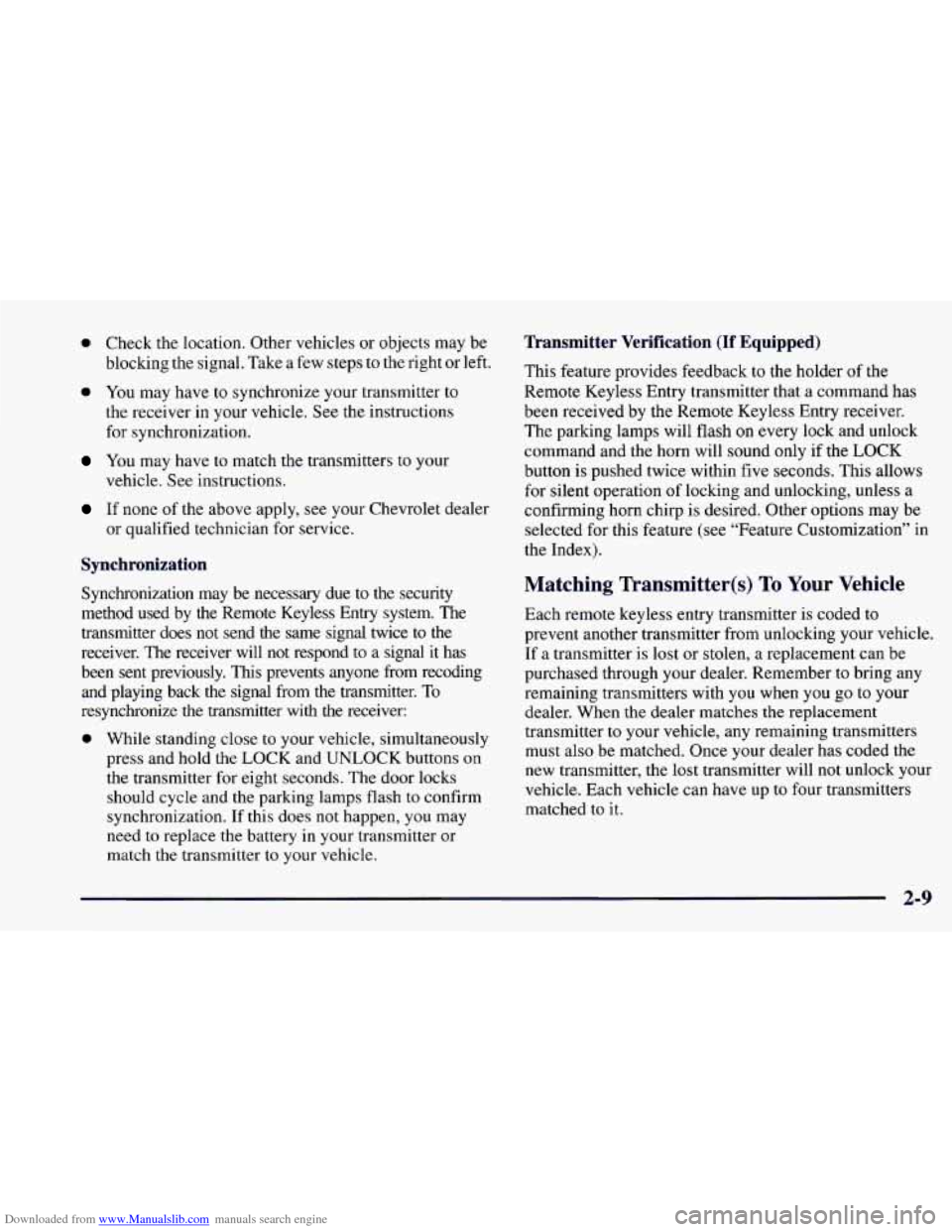
Downloaded from www.Manualslib.com manuals search engine 0 Check the location. Other vehicles or objects may be
blocking the signal. Take a few steps to the right or left.
0 You may have to synchronize your transmitter to
the receiver in your vehicle. See the instructions
for synchronization.
You may have to match the transmitters to your
vehicle. See instructions.
If none of the above apply, see your Chevrolet dealer
or qualified technician for service.
Synchronization
Synchronization may be necessary due to the security
method used by the Remote Keyless Entry system. The
transmitter does not send the same signal twice to the
receiver. The receiver will not respond to a signal it has
been sent previously. This prevents anyone from recoding
and playing back the signal from the transmitter.
To
resynchronize the transmitter with the receiver:
0 While standing close to your vehicle, simultaneously
press and hold the LOCK and
UNLOCK buttons on
the transmitter for eight seconds. The door locks
should cycle and the parking lamps flash to confirm
synchronization. If this does not happen, you may
need to replace the battery in your transmitter
or
match the transmitter to your vehicle.
Transmitter Verification (If Equipped)
This feature provides feedback to the holder of the
Remote Keyless Entry transmitter that a command has
been received by the Remote Keyless Entry receiver.
The parking lamps will flash
on every lock and unlock
command and the horn will sound only if the
LOCK
button is pushed twice within five seconds. This allows
for silent operation of locking and unlocking, unless a
confirming horn chirp is desired. Other options may be
selected for this feature (see “Feature Customization” in
the Index).
Matching Transmitter(s) To Your Vehicle
Each remote keyless entry transmitter is coded to
prevent another transmitter from unlocking your vehicle.
If a transmitter is lost or stolen, a replacement can be
purchased through your dealer. Remember to bring any
remaining transmitters with you when you go to your
dealer. When the dealer matches the replacement
transmitter to your vehicle, any remaining transmitters
must also be matched. Once your dealer has coded the
new transmitter, the lost transmitter will not unlock your
vehicle. Each vehicle can have up to four transmitters
matched
to it.
2-9
Page 67 of 404
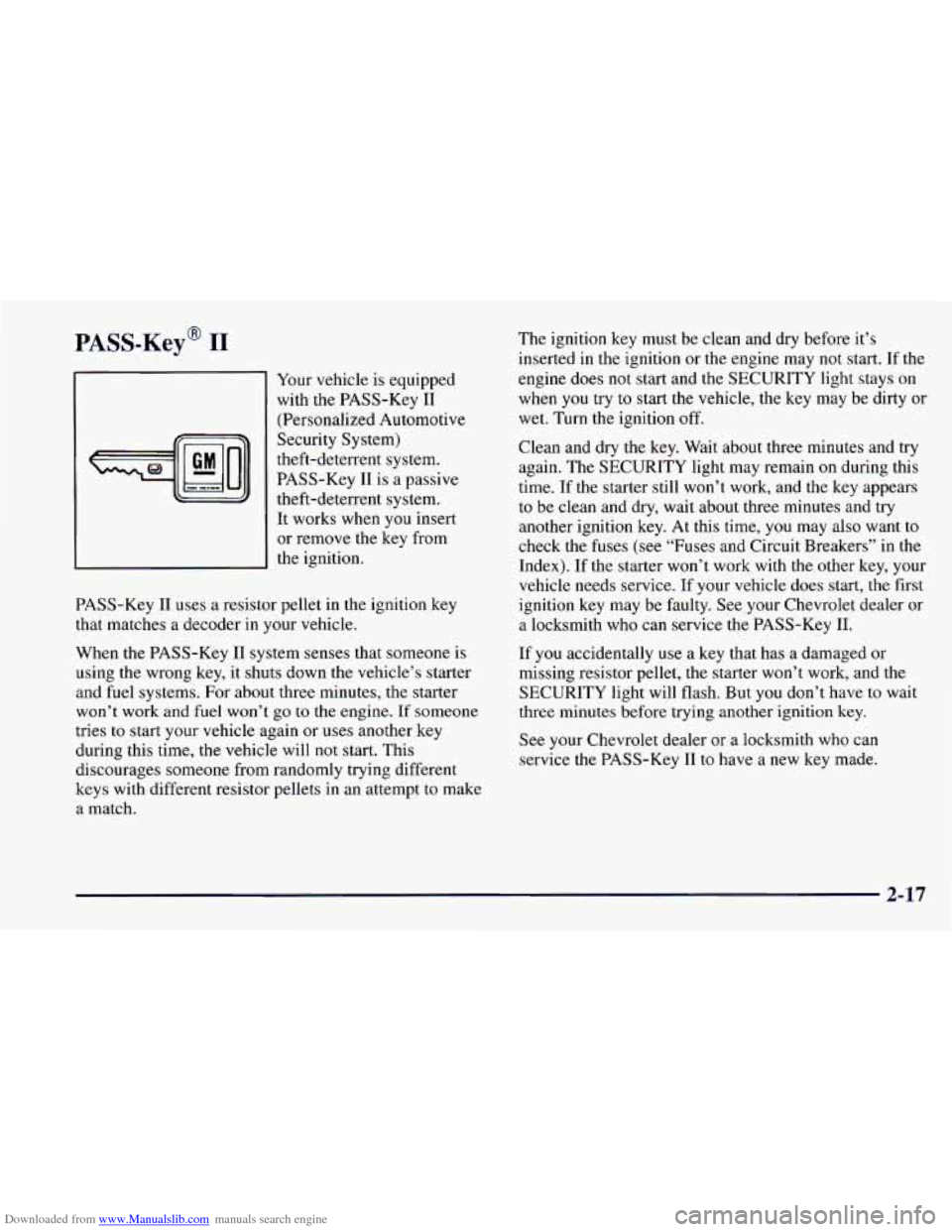
Downloaded from www.Manualslib.com manuals search engine PASS-Key@ I1
Your vehicle is equipped
with the PASS-Key I1
(Personalized Automotive
Security System)
theft-deterrent system.
PASS-Key
I1 is a passive
theft-deterrent system. It works when you insert
or remove the key from
the ignition.
PASS-Key 11 uses a resistor pellet in the ignition key
that matches a decoder in your vehicle.
When the PASS-Key I1 system senses that someone is
using the wrong key, it shuts down the vehicle’s starter
and fuel systems. For about three minutes, the starter
won’t work and fuel won’t
go to the engine. If someone
tries
to start your vehicle again or uses another key
during this time, the vehicle will not start. This
discourages someone from randomly trying different
keys with different resistor pellets in an attempt to make
a match. The
ignition key must be clean and dry before it’s
inserted in the ignition
or the engine may not start. If the
engine does not start and the SECURITY light stays on
when
you try to start the vehicle, the key may be dirty or
wet. Turn the ignition
off.
Clean and dry the key. Wait about three minutes and try
again. The SECURITY light may remain
on during this
time.
If the starter still won’t work, and the key appears
to be clean and dry, wait about three minutes and try
another ignition key. At this time,
you may also want to
check the fuses
(see “Fuses and Circuit Breakers” in the
Index). If the starter won’t work with the other key, your
vehicle needs service. If your vehicle does start, the first
ignition key may be faulty. See your Chevrolet dealer or
a locksmith who can service the PASS-Key 11.
If
you accidentally use a key that has a damaged or
missing resistor pellet, the starter won’t work, and
the
SECURITY light will flash. But you don’t have to wait
three minutes before trying another ignition key.
See your Chevrolet dealer or a locksmith who can
service the PASS-Key
I1 to have a new key made.
2-17
Page 68 of 404
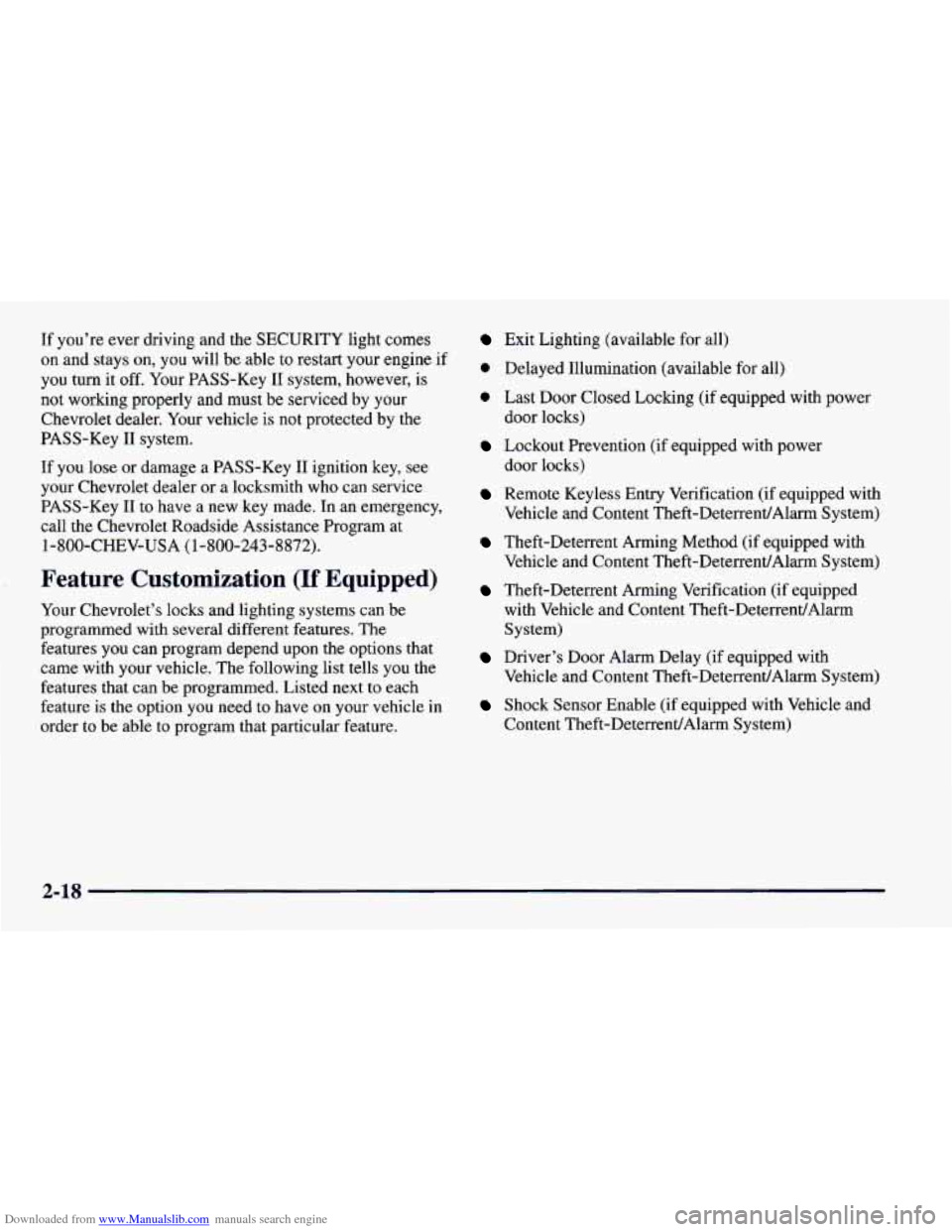
Downloaded from www.Manualslib.com manuals search engine If you’re ever driving and the SECURITY light comes
on and stays on, you will be able
to restart your engine if
you turn
it off. Your PASS-Key I1 system, however, is
not working properly and must be serviced by your
Chevrolet dealer. Your vehicle is not protected by the
PASS-Key
I1 system.
If you lose or damage a PASS-Key
I1 ignition key, see
your Chevrolet dealer
or a locksmith who can service
PASS-Key I1 to have a new key made. In an emergency,
call the Chevrolet Roadside Assistance Program at
1-800-CHEV-USA (1-800-243-8872).
Feature Customization (If Equipped)
Your Chevrolet’s locks and lighting systems can be
programmed with several different features. The
features you can program depend upon the options that
came with your vehicle. The following list tells
you the
features that can be programmed. Listed next to each
feature is the option you need
to have on your vehicle in
order to be able to program that particular feature.
Exit Lighting (available for all)
0 Delayed Illumination (available for all)
0 Last Door Closed Locking (if equipped with power
door locks)
Lockout Prevention (if equipped with power
door locks)
Remote Keyless Entry Verification (if equipped with
Vehicle and Content Theft-Deterrent/Alarm System)
Theft-Deterrent Arming Method (if equipped with
Vehicle and Content Theft-DeterrentIAlarm System)
Theft-Deterrent Arming Verification (if equipped
with Vehicle and Content Theft-DeterrendAlarm
System)
Driver’s Door Alarm Delay (if equipped with
Vehicle and Content Theft-DeterredAlarm System)
Shock Sensor Enable (if equipped with Vehicle and
Content Theft-DeterrenVAlarm System)
2-18
Page 75 of 404
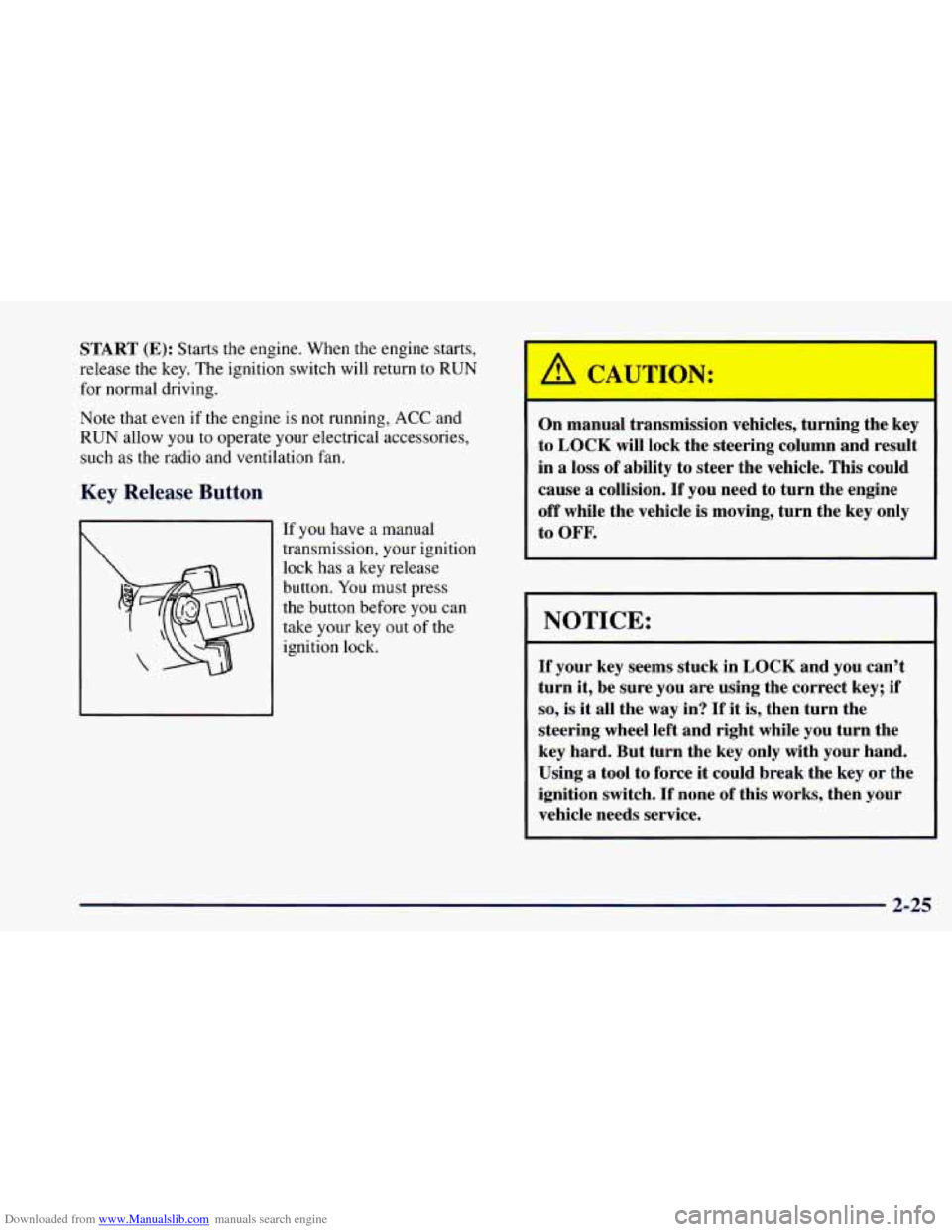
Downloaded from www.Manualslib.com manuals search engine START (E): Starts the engine. When the engine starts,
release the key. The ignition switch will return to
RUN
for normal driving.
Note that even if the engine is not running,
ACC and
RUN allow you to operate your electrical accessories,
such as the radio and ventilation fan.
Key Release Button
If you have a manual
transmission, your ignition
lock has a key release
button.
You must press
the button before
you can
take your key
out of the
ignition lock. On manual transmission
vehicles, turning the key
to
LOCK will lock the steering column and result
in
a loss of ability to steer the vehicle. This could
cause
a collision. If you need to turn the engine
off while the vehicle is moving, turn the key only
to OFF.
NOTICE:
If your key seems stuck in LOCK and you can’t
turn it, be sure you are using the correct key; if
so, is it all the way in? If it is, then turn the
steering wheel left and right while you turn the
key hard. But turn the key only with your hand.
Using
a tool to force it could break the key or the
ignition switch.
If none of this works, then your
vehicle needs service.
2-25
Page 128 of 404
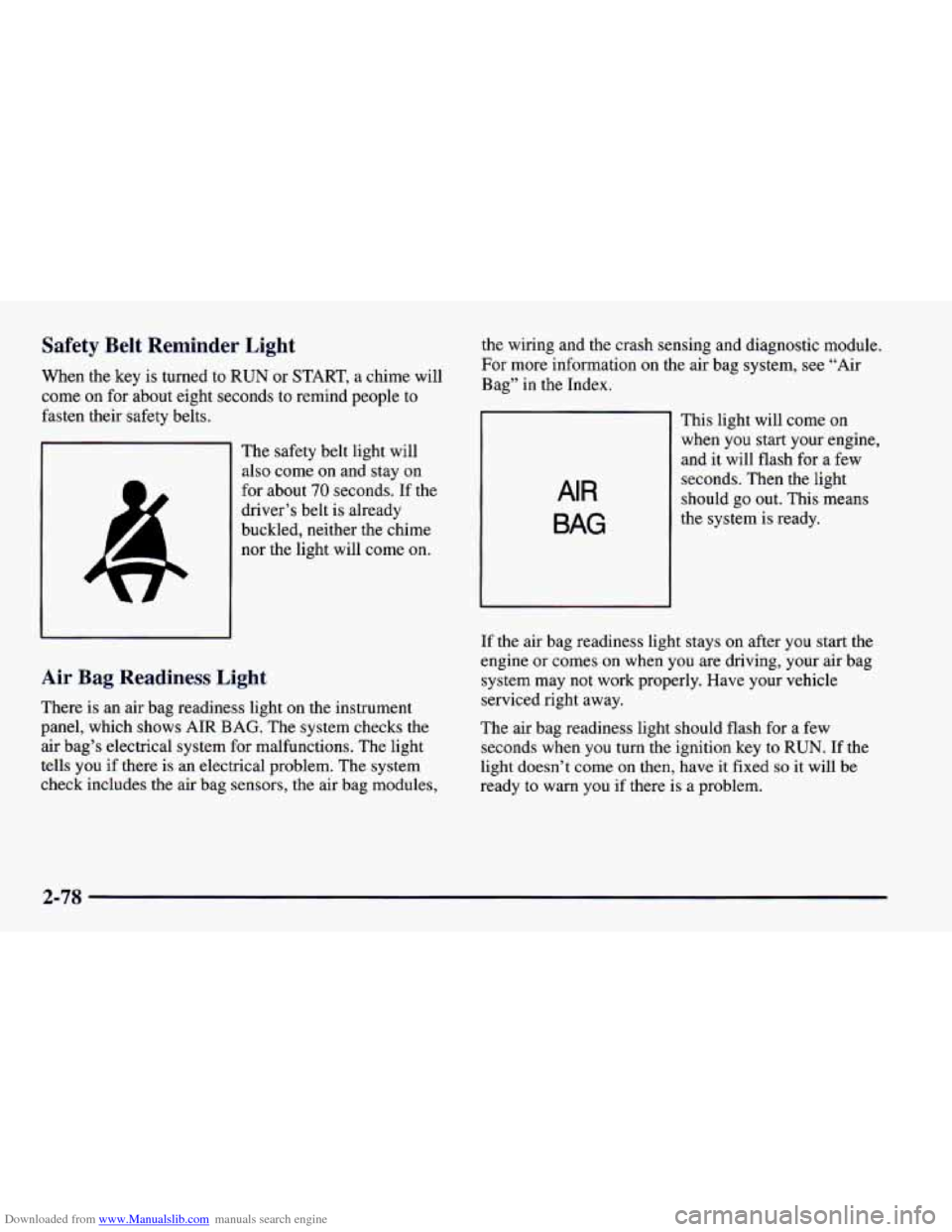
Downloaded from www.Manualslib.com manuals search engine Safety Belt Reminder Light
When the key is turned to RUN or START, a chime will
come on for about eight seconds to remind people to
fasten their safety belts.
The safety belt light will
also come on and stay on
for about
70 seconds. If the
driver’s belt is already
buckled, neither the chime
nor the light will come
on.
Air Bag Readiness Light
There is an air bag readiness light on the instrument
panel, which shows
AIR BAG. The system checks the
air bag’s electrical system for malfunctions. The light
tells you if there is an electrical problem. The system
check includes the air bag sensors, the air bag modules, the wiring and the
crash sensing and diagnostic module.
For more information on the air bag system, see “Air
Bag” in the Index.
AIR
BAG
This light will come on
when you start your engine,
and it will flash for
a few
seconds. Then the light
should go out. This means
the system is ready.
If the air bag readiness light stays on after you start the
engine or comes
on when you are driving, your air bag
system may not work properly. Have your vehicle
serviced right away.
The air bag readiness light should flash for a few
seconds when you turn the ignition key to
RUN. If the
light doesn’t come on then, have
it fixed so it will be
ready to warn you if there is a problem.
2-78